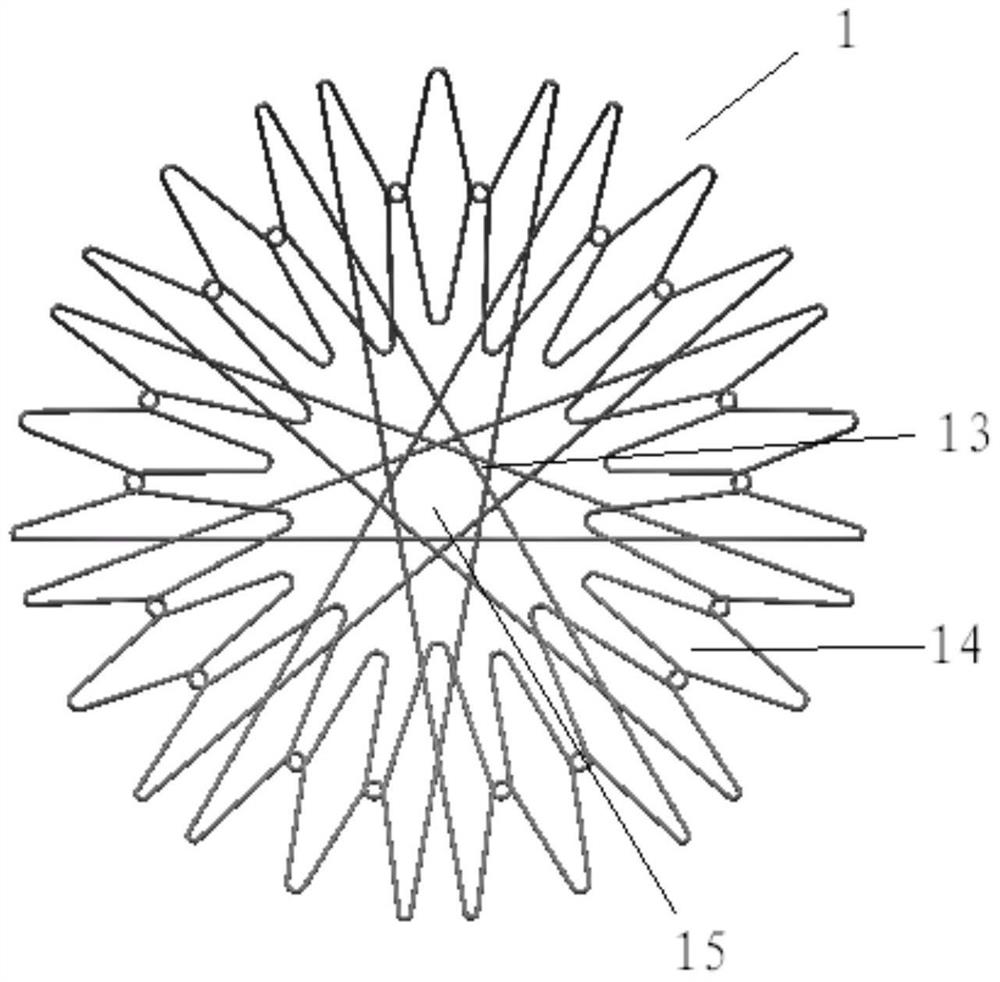A kind of slow-release drug stent for nasal cavity and its formation method and application
A slow-release drug and nasal cavity technology, applied in the field of medical devices, can solve the problems of untreated inflammation, unsatisfactory treatment of sinusitis and allergic rhinitis, etc., to eliminate postoperative adhesions, promote mucosal healing, and reduce mucosal inflammation and edema effect
- Summary
- Abstract
- Description
- Claims
- Application Information
AI Technical Summary
Problems solved by technology
Method used
Image
Examples
Embodiment 1
[0045] figure 1 It is a three-dimensional schematic diagram of a sustained-release drug stent according to the first embodiment of the present invention. The sustained-release drug stent 1 includes a main body 11 and a bottom 12 that are respectively interwoven with degradable silk threads or degradable silk bundles to form a grid structure. The main body 11 extends circumferentially and has opposite ends 111 , 112 , the bottom 12 protrudes outwards in a curved shape, and the peripheral edge 121 of the bottom 12 is aligned with the edge of the end 112 . In fact, the above-mentioned main body 11 and bottom 12 are two parts artificially divided, and these two parts are not necessarily connected at the position shown in the figure. 12 drug stents are distinguished. In this embodiment, the main body 11 and the bottom 12 are integrally formed by winding in a weaving manner. Of course, it should be understood that it is also feasible to form the main body 11 and the bottom 12 sepa...
Embodiment 2
[0053] image 3 It is a three-dimensional schematic diagram of a degradable sustained-release drug stent according to the second embodiment of the present invention. The degradable sustained-release drug stent 2 also includes a main body and a bottom that are respectively interwoven with degradable silk threads or degradable silk bundles to form a grid structure , which with figure 1 Details that are the same as or similar to those of the first embodiment will not be repeated here. The difference is that the grid structure of the main body and the bottom of the drug support 2 does not include triangular structures, but only quadrilaterals 24 or polygons 25 . In this way, the drug stent 2 of this embodiment is more easily compressed and deformed to a smaller shape, which facilitates the delivery of the stent to a narrower space. In particular, the drug stent 2 is suitable for the middle meatus, the upper meatus, the lower meatus, etc., and can also be placed inside sinuses su...
Embodiment 3
[0055] Figure 4 It is a three-dimensional schematic diagram of a degradable sustained-release drug stent according to the third embodiment of the present invention. The degradable sustained-release drug stent 3 also includes a main body and a bottom that are respectively interwoven with degradable silk threads or degradable silk bundles to form a grid structure , wherein, the grid structure at the bottom includes a triangular structure 33 to ensure the support force and dimensional stability of the stent, and is suitable for implantation in parts with large openings. The grid structure of the main body includes a quadrilateral structure 34 to facilitate the delivery of the stent to the nasal cavity. other with figure 1 The same or similar specific details of the first embodiment will not be repeated here. The difference is that the main body of the drug stent 3 in this embodiment has less material, which ensures more support while minimizing the reduction in the support perfo...
PUM
 Login to View More
Login to View More Abstract
Description
Claims
Application Information
 Login to View More
Login to View More - R&D
- Intellectual Property
- Life Sciences
- Materials
- Tech Scout
- Unparalleled Data Quality
- Higher Quality Content
- 60% Fewer Hallucinations
Browse by: Latest US Patents, China's latest patents, Technical Efficacy Thesaurus, Application Domain, Technology Topic, Popular Technical Reports.
© 2025 PatSnap. All rights reserved.Legal|Privacy policy|Modern Slavery Act Transparency Statement|Sitemap|About US| Contact US: help@patsnap.com



